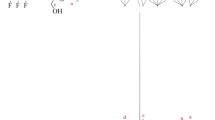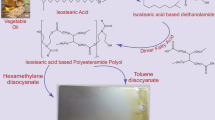Abstract
This study used 5H–octafluoropentanoylfluoride and 2-amino-2-methyl-1,3-propanediol to synthesize a novel fluoro chain extender 2,2,3,3,4,4,5,5-octafluoro-N-(1,3-dihydroxy-2-methylpropan-2-yl) pentanamide (ODMP). Furthermore, 4,4′-diphenylmethane diisocyanate served as the hard segment, polycaprolactone diol (PCL) served as the soft segment, and ODMP served as the chain extender in the novel synthesized polyurethanes (ODMP/PUs). Gel permeation chromatography revealed that the molecular weight of the ODMP/PUs increased when the ODMP content was increased. 1H and 19F nuclear magnetic resonance and Fourier transform infrared spectroscopy verified that the ODMP chain extenders were successfully synthesized and that the ODMP chain extenders were successfully incorporated into the backbone of the PUs. The interaction between the -NH (hydrogen bond) and CF2 groups in the ODMP/PUs became stronger when the ODMP content was increased. Thermal analysis revealed that the initial decomposition temperature of the ODMP/PUs decreased and the second decomposition temperature increased when the polymers’ ODMP content was increased. Higher ODMP content also resulted in the ODMP/PUs’ higher glass transition and dynamic glass transition temperatures and lower ODMP maximum stress and Young’s modulus, causing a lower elongation at break. ODMP/PUs with higher ODMP content exhibited more protrusions and more rugged surfaces. The chemical resistance of the ODMP/PUs increased when the fluorine content was increased. Scanning electron microscopy revealed that ODMP/PUs with higher PCL content exhibited higher levels of hydrolytic degradation. Finally, in vitro erythrocyte tests revealed that increasing the ODMP chain extender content reduced the average number of erythrocytes adhering to the surface of the PUs.




















Similar content being viewed by others
References
Ratna D, Karger-Kocsis J (2008) Recent advances in shape memory polymers and composites: a review. J Mater Sci 43:254–269
Tien YI, Wei KH (2001) Hydrogen bonding and mechanical properties in segmented montmorillonite/polyurethane nanocomposites of different hard segment ratios. Polymer 42:3213–3221
Abraham GA, de Queiroz AAA, San Roman JS (2001) Hydrophilic hybrid IPNs of segmented polyurethanes and copolymers of vinylpyrrolidone for applications in medicine. Biomaterials 22:1971–1985
Mequanint K, Sanderson R (2003) Nano-structure phosphorus- containing polyurethane dispersions: synthesis and crosslinking with melamine formaldehyde resin. Polymer 44:2631–2639
Park HB, Lee YM (2002) Separation of toluene/nitrogen through segmented polyurethane and polyurethane urea membranes with different soft segments. J Membrane Sci 197:283–296
Gugliuzza A, Clarizia G, Golemme G, Drioli E (2002) New breathable and waterproof coatings for textiles: effect of an aliphatic polyurethane on the formation of PEEK-WC porous membranes. Eur Polym J 38:235–242
Kawakami H, Mikawa M, Takagi J, Nagaoka S (1996) Gas transfer and blood compatibility of fluorinated polyimide membranes. J Biomater Sci Polym En 7:1029–1038
Furukawa M (1994) Property-structure relationships of polyurethane elastomers: imrovement of hydrolytic stability and thermal stability. J Appl Polym Sci-Appl Polym Symp 53:61–76
Tonelli C, Trombetta T, Scicchitano M, Castiglioni G (1995) New perfluoropolyether soft segment containing polyurethanes. J Appl Polym Sci 57:1031–1042
Sawada H (1996) Fluorinated peroxides. Chem Rev 96:1779–1808
Sawada H, Ariyoshi Y, Lee L, Kyokane J, Kawase T (2000) A new approach to highly conductive polymer electrolytes: synthesis of gelling fluoroalkylated end-capped 2-acrylamido-2- methylpropanesulfonic acid copolymers containing poly(oxyethylene) units. Eur Polym J 36:2523–2526
Ho T, Wynne KJ (1992) A new fluorinated polyurethane: polymerization, characterization, and mechanical properties. Macromolecules 25:3521–3527
Honeychuck RV, Ho T, Wynne KJ, Nissan RA (1993) Preparation and characterization of polyurethanes based on a series of fluorinated diols. Chem Mater 5:1299–1306
Su T, Wang GY, Wang SL, Hu CP (2010) Fluorinated siloxane- containing waterborne polyurethaneureas with excellent hemocompatibility, waterproof and mechanical properties. Eur Polym J 46:472–483
Kashiwagi T, Ito Y, Imanishi Y (1993) Synthesis of non-throm- bogenicity of fluoroalkyl poly-ether-urethanes. J Biomat Sci Polym Ed 5:157–166
Wanga LF, Wei YH (2005) Effect of soft segment length on properties of fluorinated polyurethanes. Colloid Surf B-Biointerfaces 41:249–255
Chen KY, Kuo JF (2000) Synthesis and properties of novel fluorinated aliphatic polyurethanes with fluoro chain extenders. Macromol Chem Phys 201:2676–2686
Wang LF (2007) Experimental and theoretical characterization of the morphologies in fluorinated polyurethanes. Polymer 48:894–900
Wu CL, Chiu SH, Lee HT, Suen MC (2016) Synthesis and properties of biodegradable polycaprolactone/polyurethanes using fluoro chain extenders. Polym Adv Technol 27:665–676
Su SK, Gu JH, Lee HT, Yu SH, Wu CL, Suen MC (2016) Effects of an aromatic Fluoro-diol and Polycaprolactone on the properties of the resultant polyurethanes. Adv Polym Technol. doi:10.1002/adv.21773
Ge Z, Zhang XY, Dai JB, Li WH, Luo YJ (2008) Synthesis and characterization of fluorinated polyurethane with fluorine-containing pendent groups. Chin Chem Lett 19:1293–1296
Ge Z, Zhang X, Dai J, Li W, Luo Y (2009) Synthesis, characterization and properties of a novel fluorinated polyurethane. Eur Polym J 45:530–536
Tonelli C, Ajroldi G (2003) New fluoro-modified thermoplastic polyurethanes. J Appl Polym Sci 87:2279–2294
Tonelli C, Trombetta T, Scicchitano M, Simeone G, Ajroldi G (1996) New fluorinated thermoplastic elastomers. J Appl Polym Sci 59:311–327
Tonellia C, Ajroldi G, Turturro A, Marigo A (2001) Synthesis methods of fluorinated polyurethanes. 1. Effects on thermal and dynamic-mechanical behaviours. Polymer 42:5589–5598
Tao L, Lin Y (2010) Synthesis and properties of fluorinated thermoplastic polyurethane elastomer. J Fluor Chem 131:36–41
Mohanty AK, Misra M, Hinrinchsen G (2000) Biofibres, biodegradable polymers and biocomposites: an overview. Macromol Mater Eng 276-277:1–24
Mohanty AK, Misra M, Drzal LT (2002) Sustainable bio-composites from renewable resources: opportunities and challenges in the green materials world. J Polym Environ 10:19–26
Gunatillake P, Mayadunne R, Adhikari R, El-Gewely MR (2006) Recent developments in biodegradable synthetic polymers. Biotechnol Annu Rev 12:301–347
Pena J, Corrales T, Izquierdo-Barba I, Doadrio AL, Vallet-Regi M (2006) Long term degradation of poly(ε-caprolactone) films in biologically related fluids. Polym Degrad Stab 91:1424–1432
Okada M (2002) Chemical syntheses of biodegradable polymers. Prog Polym Sci 27:87–133
Nair LS, Laurencin CT (2007) Biodegradable polymers as biomaterials. Prog Polym Sci 32:762–798
Coulembier O, Degee P, Hedrick JL, Dubois P (2006) From controlled ring-opening polymerization to biodegradable aliphatic polyester: especially poly(b-malic acid) derivatives. Prog Polym Sci 31:723–747
Chandra R, Rustgi R (1998) Biodegradable polymers. Prog Polym Sci 23:1273–1335
Li FG, Hou JN, Zhu W, Zhang XA, Xu M, Luo XL (1996) Crystallinity and morphology of segmented polyurethanes with different soft-segment length. J Appl Polym Sci 62:631–638
Jeong HM, Ahn BK, Kim BK (2001) Miscibility and shape memory effect of thermoplastic polyurethane blends with phenoxy resin. Eur Polym J 37:2245–2252
Velankar S, Cooper SL (1998) Microphase separation and rheological properties of polyurethane melts. 1. Effect of block length. Macromolecules 31:9181–9192
Dadbin S, Frounchi M (2003) Effects of polyurethane soft segment and crosslink density on the morphology and mechanical properties of polyurethane/poly(allyl diglycol carbonate) simultaneous interpenetrating polymer networks. J Appl Polym Sci 89:1583–1595
Tsou CH, Lee HT, Tsai HA, Cheng HJ, Suen MC (2013) Synthesis and properties of biodegradable polycaprolactone/polyurethanes by using 2,6-pyridinedimethanol as a chain extender. Polym Degrad Stab 98:643–650
Jiang X, Li JH, Ding MM, Tan H, Ling QY, Zhong YP (2007) Synthesis and degradation of nontoxic biodegradable waterborne polyurethanes elastomer with poly(ε-caprolactone) and poly(ethylene glycol) as soft segment. Eur Polym J 43:1838–1846
Brunette CM, Hsu SL, Macknight WJ (1982) Hydrogen-bonding properties of hard-segment model compounds in polyurethane block copolymers. Macromolecules 15:71–77
Chen SJ, Hu J, Zhuo HT, Yuen CW, Chan LK (2010) Study on the thermal-induced shape memory effect of pyridine containing supramolecular polyurethane. Polymer 51:240–248
Ferraria AM, Silva JDL, Rego AMB (2003) XPS studies of directly fluorinated HDPE: problems and solutions. Polymer 44:7241–7249
Arun Prasath R, Nanjundan S, Pakula T, Klapper M (2004) Thermal and dynamic mechanical behaviour of calcium containing co-polyurethanes. Polym Degrad Stabil 85:911–923
Brandsch R, Bar G, Whangbo MH (1997) On the factors affecting the contrast of height and phase images in tapping mode atomic force microscopy. Langmuir 13:6349–6353
Sauer BB, Mclean RS, Thomas RR (1998) Tapping mode AFM studies of Nano-phases on fluorine-containing polyester coatings and Octadecyltrichlorosilane monolayers. Langmuir 14:3045–3051
Author information
Authors and Affiliations
Corresponding author
Rights and permissions
About this article
Cite this article
Su, SK., Gu, JH., Lee, HT. et al. Synthesis and properties of novel biodegradable polyurethanes containing fluorinated aliphatic side chains. J Polym Res 24, 142 (2017). https://doi.org/10.1007/s10965-017-1301-9
Received:
Accepted:
Published:
DOI: https://doi.org/10.1007/s10965-017-1301-9




